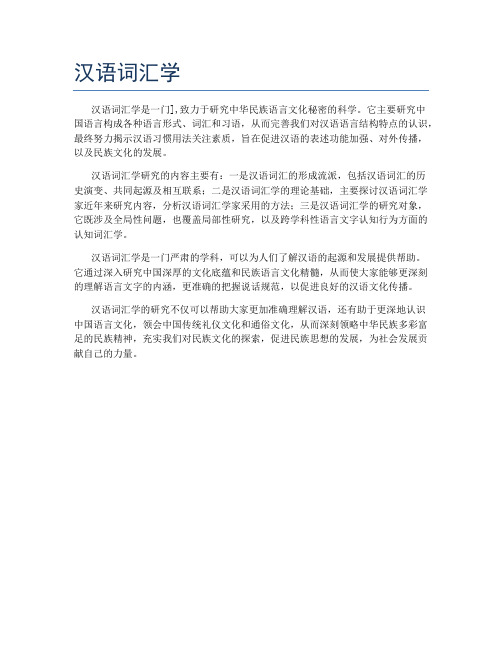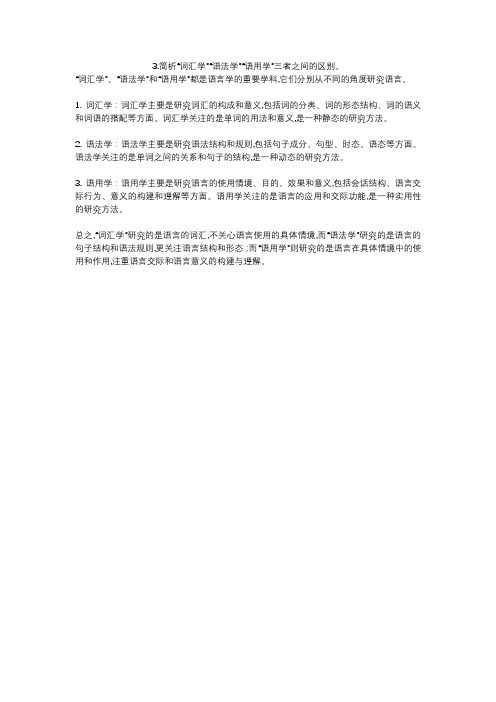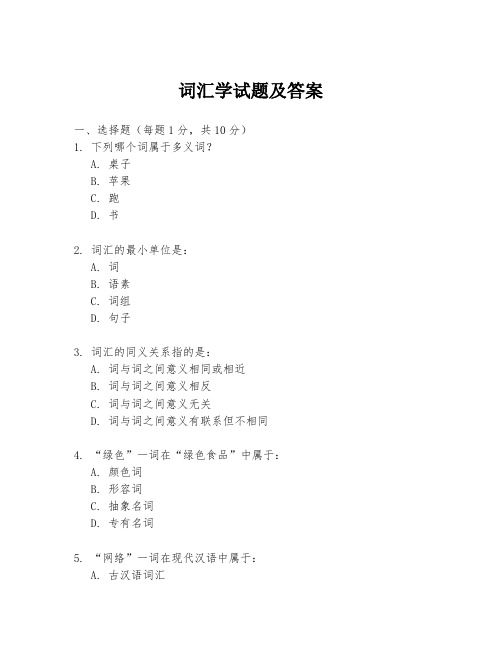词汇学
词汇学试题及答案

词汇学试题及答案一、选择题(每题2分,共20分)1. 词汇学是研究语言中词汇的科学,它主要研究的是语言中的()。
A. 词汇的构成B. 词汇的意义C. 词汇的运用D. 词汇的演变答案:A2. 下列哪一项不是词汇学的研究内容?()A. 词义的演变B. 词义的分类C. 词义的辨析D. 语法规则答案:D3. 词汇学中,词素是指()。
A. 构成词的基本单位B. 词的发音单位C. 词的书写单位D. 词的意义单位答案:A4. 在词汇学中,语义场是指()。
A. 词义的分类B. 词义的演变C. 词义的辨析D. 一组词义相关的词答案:D5. 词汇学研究中,同义词是指()。
A. 意义完全相同的词B. 意义相近的词C. 形式相同的词D. 用法相同的词答案:B6. 下列哪一项不是词汇学中词义的分类?()A. 抽象意义B. 具体意义C. 语法意义D. 色彩意义答案:C7. 词汇学中,词义的演变通常包括()。
A. 词义的扩大B. 词义的缩小C. 词义的转移D. 以上都是答案:D8. 词汇学中,词义的辨析主要研究的是()。
A. 词与词之间的联系B. 词与词之间的差异C. 词与词之间的相似性D. 词与词之间的对立答案:B9. 在词汇学中,词义的模糊性是指()。
A. 词义的不确定性B. 词义的明确性C. 词义的多重性D. 词义的单一性答案:A10. 词汇学中,词义的多义性是指()。
A. 一个词有多种意义B. 一个词只有一种意义C. 一个词的意义是固定的D. 一个词的意义是单一的答案:A二、填空题(每题2分,共20分)1. 词汇学中的词素是指构成词的________。
答案:基本单位2. 语义场是指一组________的词。
答案:词义相关3. 同义词是指意义________的词。
答案:相近4. 词义的演变包括词义的________、________和________。
答案:扩大、缩小、转移5. 词义的辨析主要研究的是词与词之间的________。
汉语词汇学

汉语词汇学
汉语词汇学是一门],致力于研究中华民族语言文化秘密的科学。
它主要研究中
国语言构成各种语言形式、词汇和习语,从而完善我们对汉语语言结构特点的认识,最终努力揭示汉语习惯用法关注素质,旨在促进汉语的表述功能加强、对外传播,以及民族文化的发展。
汉语词汇学研究的内容主要有:一是汉语词汇的形成流派,包括汉语词汇的历
史演变、共同起源及相互联系;二是汉语词汇学的理论基础,主要探讨汉语词汇学家近年来研究内容,分析汉语词汇学家采用的方法;三是汉语词汇学的研究对象,它既涉及全局性问题,也覆盖局部性研究,以及跨学科性语言文字认知行为方面的认知词汇学。
汉语词汇学是一门严肃的学科,可以为人们了解汉语的起源和发展提供帮助。
它通过深入研究中国深厚的文化底蕴和民族语言文化精髓,从而使大家能够更深刻的理解语言文字的内涵,更准确的把握说话规范,以促进良好的汉语文化传播。
汉语词汇学的研究不仅可以帮助大家更加准确理解汉语,还有助于更深地认识
中国语言文化,领会中国传统礼仪文化和通俗文化,从而深刻领略中华民族多彩富足的民族精神,充实我们对民族文化的探索,促进民族思想的发展,为社会发展贡献自己的力量。
词汇学Word-Meaningppt课件

(3).Social meaning: Based on: ①the social relationship between the
speakers;②the occasion;③the subject matter;④ the mode of speech;etc. eg: What’s your age? (对求职者)
14
2.Lexical meaning:
(1).Denotative meaning: It is the central factor in linguistic communication. eg: chair → 椅子 mother → 母亲 man → 男人 woman → 女人 politician → 政客 blood → 血液 chicken → 小鸡 adumeaning: eg: chair → 官位 mother → love, care, tenderness man → 勇敢,强壮,责任心,大度 woman → 意志薄弱,爱流泪,多情善感 (Anyway,she is a woman.) politician → 欺诈,夸夸其谈 blood → 出身,亲情,民族 (Blood is thicker than water. He has Canadian blood) chicken → 懦弱,胆怯 adult → 责任
你吃了吗? (denotative meaning; connotative meaning)
17
(4).Affective meaning: a.Interjections: Oh! Alas! Ouch! b.Approval and disapproval: mother, scholar, masterpiece, career, buzz, gang, boast, workaholic, etc. c.Bias: slender — skinny, statesman — politician, famous — notorious proud — arrogant (褒义) (贬义)
3.简析“词汇学”“语法学”“语用学”三者之间的区别。

3.简析“词汇学”“语法学”“语用学”三者之间的区别。
“词汇学”、“语法学”和“语用学”都是语言学的重要学科,它们分别从不同的角度研究语言。
1. 词汇学:词汇学主要是研究词汇的构成和意义,包括词的分类、词的形态结构、词的语义和词语的搭配等方面。
词汇学关注的是单词的用法和意义,是一种静态的研究方法。
2. 语法学:语法学主要是研究语法结构和规则,包括句子成分、句型、时态、语态等方面。
语法学关注的是单词之间的关系和句子的结构,是一种动态的研究方法。
3. 语用学:语用学主要是研究语言的使用情境、目的、效果和意义,包括会话结构、语言交际行为、意义的构建和理解等方面。
语用学关注的是语言的应用和交际功能,是一种实用性的研究方法。
总之,“词汇学”研究的是语言的词汇,不关心语言使用的具体情境,而“语法学”研究的是语言的句子结构和语法规则,更关注语言结构和形态;而“语用学”则研究的是语言在具体情境中的使用和作用,注重语言交际和语言意义的构建与理解。
词汇学试题及答案

词汇学试题及答案一、选择题(每题1分,共10分)1. 下列哪个词属于多义词?A. 桌子B. 苹果C. 跑D. 书2. 词汇的最小单位是:A. 词B. 语素C. 词组D. 句子3. 词汇的同义关系指的是:A. 词与词之间意义相同或相近B. 词与词之间意义相反C. 词与词之间意义无关D. 词与词之间意义有联系但不相同4. “绿色”一词在“绿色食品”中属于:A. 颜色词B. 形容词C. 抽象名词D. 专有名词5. “网络”一词在现代汉语中属于:A. 古汉语词汇B. 外来词C. 新词D. 专业术语6. 下列哪个词属于反义词?A. 快-慢B. 男-女C. 长-短D. 老-少7. 词汇的构成方式不包括:A. 合成B. 派生C. 借用D. 音译8. “美丽”一词的词性是:A. 名词B. 动词C. 形容词D. 副词9. “电脑”一词的构词方式是:A. 合成B. 派生C. 借用D. 音译10. 下列哪个词属于外来词?A. 电视B. 电话C. 网络D. 汽车二、填空题(每空1分,共10分)11. 词汇学是研究语言中________的学科。
12. 词义的演变通常包括词义的________、________和________。
13. 词义的________是指词义在特定语境下临时改变的现象。
14. 词汇的________是指词义的扩大,能够涵盖更多的事物或现象。
15. 词汇的________是指词义的缩小,只能指特定的事物或现象。
三、简答题(每题5分,共10分)16. 简述词汇的构成方式有哪些?17. 简述词义演变的类型。
四、论述题(每题15分,共30分)18. 论述词汇学在语言教学中的重要性。
19. 论述词汇的同义关系和反义关系在语言表达中的作用。
五、案例分析题(共40分)20. 请分析“手机”一词的词义演变过程,并讨论其对现代汉语词汇发展的影响。
(20分)21. 以“环保”为例,分析词汇的派生构成方式及其在现代社会中的应用。
词汇学基本理论

词汇学基本理论词汇学基本理论一、词的定义词是语音、意义和语法特点三者统一的整体。
二、词的语音和意义1、派别1)自然派:认为音和义之间存在着必然的联系。
2)习惯派:认为音和义之间没有必然的联系。
如:meat(肉)汉语(ròu)法语(viande)意大利语(carne)瑞典语(kott)sight(视力)site(场所)cite(引证)三、词的词汇意义和语法意义语法意义不同,往往会引起词汇意义的一些改变、如:He tore down the hill.Three enemy plans were downed yesterday.有些词只适合在特定的语境(context)中使用,常常带有语体色彩。
如:But(v.)me no buts(n.). 别老找理由。
四、词与词汇1、关系:个体与总体的关系,词的总和构成语言的词汇2、词汇:不仅指语言中所有的词,还包括方言、使用域、术语等某一语言变体中使用的词和短语3、词汇的分类英语词汇目前共计约200多万,包括本族词(native words)和外来词(borrowed words),其中本族词为基本词汇,他们在语言中使用最多。
所以又被称为“高频词”。
外来词:拉丁语、丹麦语、法语、德语、意大利语、西班牙语、阿拉伯语、日语等。
五、词的组成单位——形位(又称为:词素)1、形位的概念:是最小的语法单位,也是最小的语义单位。
2、类型:词是由形位构成的,有的词只有一个形位,如log, clerk solider等,有的词有多个形位,如lovely有love 和ly 两个形位,unfriendly有un,friend,ly 三个形位。
六、实义形位、语法形位1)实义形位:构成词的语义基础,可以单独使用,有独立的意义,所以又称为自由形位或自由词素。
这种形位相当于词根(root)如:teacher中的teach 2)语法形位:只表示附加意义或语法意义,必须依附于其他形位与之结合才能使用,所以,又被称之为“粘附形位”或“粘附词素”。
词汇学期末考试题及答案
词汇学期末考试题及答案一、选择题(每题2分,共20分)1. 词汇学研究的核心对象是()。
A. 语音B. 语法C. 词汇D. 语义答案:C2. 词义的最小单位是()。
A. 语素B. 词C. 短语D. 句子答案:A3. 以下哪个词属于多义词?()A. 桌子B. 苹果C. 跑D. 笔答案:C4. 词义的演变通常不包括()。
A. 词义扩大B. 词义缩小C. 词义转移D. 词义创新答案:D5. 以下哪个词属于外来词?()A. 沙发B. 电脑C. 汽车D. 火车答案:A6. 词义的引申通常是基于()。
A. 词的本义B. 词的引申义C. 词的转用义D. 词的比喻义答案:A7. 以下哪个词属于同义词?()A. 快速和迅速B. 桌子和椅子C. 红色和蓝色D. 学习和平息答案:A8. 以下哪个词属于反义词?()A. 高和矮B. 桌子和椅子C. 红色和蓝色D. 学习和平息答案:A9. 以下哪个词属于成语?()A. 马到成功B. 桌子C. 红色D. 学习答案:A10. 以下哪个词属于专业术语?()A. 电脑B. 桌子C. 红色D. 学习答案:A二、填空题(每题2分,共20分)1. 词汇学是研究语言中的词汇及其变化规律的学科。
2. 词义的演变包括词义扩大、词义缩小和词义转移。
3. 多义词是指一个词具有两个或两个以上相关或不相关的意义。
4. 外来词是指从其他语言借用过来的词。
5. 词义的引申通常是基于词的本义。
6. 同义词是指意义相同或相近的词。
7. 反义词是指意义相反或相对的词。
8. 成语是指由四个或四个以上汉字组成的固定短语,具有特定的意义和用法。
9. 专业术语是指在特定领域内使用的具有特定意义的词。
10. 词汇的创新是指根据语言发展的需要,创造出新的词汇。
三、简答题(每题10分,共40分)1. 简述词汇学的研究内容。
词汇学主要研究语言中的词汇及其变化规律,包括词的构成、词义的演变、词的分类、词的用法等方面。
2. 简述词义演变的类型。
词汇学一二章作业
一、填空题1词汇是一种语言里或某一特定范围里使用的全部词和的总和。
[中山大学2011研]2固定短语可以分为专名和两类。
[北京大学2011 研]3确定语素可以采用法,区别语素和词的方法是;区别词和短语的方法是。
[河北大学2013 研」4语言中能的单位是词5“北京大学”“中国人民银行”都是,不能任意增减、改换其中的词语。
二、判断题1词由语素构成,语素是语言中最小的音义结合体。
2词汇单位包括语素、词和固定短语。
3“白纸”和“白字”都是两个成词语素构成的语言单位,都能单独回答问题,但前一个是短语,后一个才是词。
确定的方法就是替代法。
三、选择题1下面哪个简称在简化方式上不同于其它三个?()A.外长B.扫盲C.公关D.离校2下面哪个词是离合词?()A.休息B.学习C.洗澡D.修理3词和语素的区别在于()。
A.能否独立运用B.是否为最小的语言单位C.是否为最小的造句单位D.是否为最小的能够独立运用的单位4“旮旯”()。
A.不是词C.不是语素B.由一个语素构成词D.由两个语素构成词5“尴”是一个。
A.语素B.词C.音节D.短语6“坐”是一个。
A.语素B.词C.短语D.句子7下面各组词语,全是词的一组是。
A.看玻花电视B.丢蓝牛白纸C.了打向白字D.倒成尴提高8下列各项中是词的有。
A.白纸B.耳朵软C.新房D.欠债E.没说的四、名词解释固定短语五、分析题1“不小心丢了一卷绷带、一束花儿”中有几个音节?几个语素?几个词?2外国留学生学习汉语时常出现这样一类错误:“我今天见面了我的朋友、我应该鞠躬老师”,请分析此类错误的原因。
(10分)3我们平时去菜场买菜,如果问“这是什么肉”,回答只能是“牛肉”、“羊肉”或“猪肉”,而不能说“牛的肉”,为什么?“牛肉”和“牛的肉”有什么区别?五、简答题1.什么是缩略语?举例说明其类型及各类型的形成方式。
(15分)2.缩略语的类型和缩略方式有哪些?(10分)3.运用“扩展检测法”区别下列语言单位哪些是单词,哪些是短语。
英语词汇学名词解释
英语词汇学名词解释英语词汇学在英语学习和教学中,词汇是非常重要的一部分。
英语词汇学研究的是英语词汇的形成、分类、演变和使用等方面的知识。
下面是一些与英语词汇学相关的名词及其解释:1. 词汇(Vocabulary)•词汇是指某一语言系统中的全部词语的总称。
•例子:英语中的词汇包括单词(words),短语(phrases),习语(idioms)等。
2. 词义(Semantics)•词义是指词语所表示的意义或概念。
•例子:单词”apple”表示一种水果。
3. 词根(Root)•词根是构成单词的核心部分,具有词义的基本含义。
•例子:词根“tele-”表示“远程”,如单词”television”表示“远距离看”。
4. 词形(Morphology)•词形是指词语形态上的变化,包括词根的变化、词缀的添加和词语形式的变化等。
•例子:单词”run”经过词形变化可以有”running”(进行时态)和”ran”(过去时态)等形式。
5. 词汇量(Vocabulary Size)•词汇量是指一个人掌握或理解的词汇数量。
•例子:一般来说,英语水平高的人词汇量会相对较大。
6. 同义词(Synonym)•同义词是指语义相近的两个或多个词语。
•例子:“happy”和”glad”都是表示“高兴”的同义词。
7. 反义词(Antonym)•反义词是指意义相对立的两个词语。
•例子:“big”和”small”是表示“大”和“小”的反义词。
8. 多词性(Polysemy)•多词性是指一个词语具有多个不同但相关的词义。
•例子:单词”bank”可以表示“银行”或“河岸”。
9. 词汇补偿(Vocabulary Compensation)•词汇补偿是指在理解语言时,通过上下文和其他线索来推测未知词汇的意义。
•例子:如果不认识单词”obscure”,可以通过上下文来猜测它的意义是“不清楚的”。
这些名词和概念在英语词汇学中起着重要的作用,了解它们可以帮助我们更好地学习和使用英语词汇。
现代英语词汇学
现代英语词汇学一、词汇的构成(Word - formation)1. 词根(Root)- 定义:词根是单词的核心部分,它包含着单词的基本意义。
例如,“vis”在“visible”(可见的)、“vision”(视觉)和“visit”(参观)中是词根,其基本意义与“看”有关。
读音:[ruːt],词性:名词。
2. 前缀(Prefix)- 定义:加在词根前面,改变单词的意义。
例如,“un - ”在“unhappy”(不快乐的)中表示否定。
读音:[ˈpriːfɪks],词性:名词。
- 常见前缀及其意义:- “re - ”(再,又),如“rewrite”(重写)。
读音:[riː - ],词性:前缀。
- “pre - ”(在……之前),如“preview”(预习,预演)。
读音:[priː - ],词性:前缀。
3. 后缀(Suffix)- 定义:加在词根后面,改变单词的词性或意义。
例如,“ - er”在“worker”(工人)中表示“做……的人”。
读音:[ˈsʌfɪks],词性:名词。
- 常见后缀及其作用:- “ - ness”(构成名词,表示性质、状态),如“happiness”(幸福)。
读音:[nəs],词性:后缀。
- “ - ful”(构成形容词,表示充满……的),如“helpful”(有帮助的)。
读音:[fʊl],词性:后缀。
二、词性(Parts of Speech)1. 名词(Noun)- 定义:表示人、事物、地点、抽象概念等。
例如,“book”(书)、“city”(城市)、“love”(爱)。
读音:[naʊn],词性:名词。
- 名词的分类:- 可数名词(Countable Noun),如“apple”(苹果),有单复数形式。
- 不可数名词(Uncountable Noun),如“water”(水),一般没有复数形式。
2. 动词(Verb)- 定义:表示动作或状态。
例如,“run”(跑)、“be”(是)。
- 1、下载文档前请自行甄别文档内容的完整性,平台不提供额外的编辑、内容补充、找答案等附加服务。
- 2、"仅部分预览"的文档,不可在线预览部分如存在完整性等问题,可反馈申请退款(可完整预览的文档不适用该条件!)。
- 3、如文档侵犯您的权益,请联系客服反馈,我们会尽快为您处理(人工客服工作时间:9:00-18:30)。
语义学在中学教育中的应用李可欣 2012303010421 英本1204班摘要:英语在当今社会的交流中占据了主要地位,因此英语教学也变得尤为重要。
而词汇教学在中学英语教学中占据了很重要的地位,在这片文章中我将就语言学中的语义学分别从语义成分(semantic components);词的外延(denotation of words)和词之间的意义关系这三个方面来分析词汇学,并讨论其在现实中学教育中的应用。
关键词:语义学,语义成分分析,词的外延,词与词之间的意义,词汇教学1.语义学语义学研究的是语言中语义是如何编码的。
它涉及到的不仅仅是作为词汇单位词语的意义,还有语言中词之上和词之下成分的意义,例如语素意义与句子的意义。
语义学的关键为语义成分、词的外延、词之间的意义关系,还有句子之间的意义关系。
1.1语素就发音与意义之间的关系来看,语素是语言的最小单位。
语素不能再作进一步的分析。
例如,dog不能再被分为d和og。
1.2词词是一个典型的语法单位,它位于语素和词组的中间,例如,baby,water,face和high。
词具有(1)稳定性:在所有语言单位中,就内部结构来说,词是最稳定的。
(2)相对连续性:连续性是指即使一个单词有几个部分组成,中间也不能插入任何新的成分。
如disappointment这个词由三个部分组成dis、appoint、ment,但这三个部分之间不能插入任何部分也不允许有任何的停顿。
(3)最小自由形式:这种说法最开始由布龙菲尔德提出。
他提倡“把句子看作‘最大自由形式’,把词看作‘最小自由形式’”,词是能够单独构成句子的最小单位。
如以下例子:--Is John coming this party with you?--Possibly.2.意义虽然“语义学这一词仅仅只有100多年的历史,但意义一直是人类研究的话题;早在公元前五世纪,古希腊哲学家柏拉图的著作中就有关于意义的讨论。
在中国,老子甚至更早的提到了意义的相关问题。
这么多年以来,大量的词典的出版也为意义研究的历史留下的不可磨灭的铁证。
2.1语义成分语义是个涵义较为广泛的概念,它可以指词语的意义,也可以指话语的内容。
在谈及语义成分之前我们先来说说语义成分分析。
丹麦语言学家叶尔姆斯列夫(L. Hjelmslev)在1943年提出了词义可分的想法,即一个词项可以分解为一组更小的成分,例如woman这个词的语义可以分解为[human] 、[adult] 、 [female] 这几个成分。
这一设想得到了很多语言学家的支持,美国的语言学家布龙菲尔德还提出了“语义特征”(semantic feature)的术语,即语义成分(semantic component),来为这最小的意义单位命名。
随着结构主义语言学的发展,语义成分分析法(Componential Analysis)应运而生,并成为研究语义成分的核心方法。
这一方法是1956年,人类学家古迪纳夫在《成分分析以及意义研究》一文中提出的,最初只是人类学家用来分析不同语言中的亲属词语的。
随后,很多语言学家,如鲍狄埃、卡茨(J. Kats)、福多(J. A. Fodor)等人都相继提出了相关理论,引起了语法学和语义学界的高度重视。
简单说就是:语义成分分析就是从一组意义相关的词语中抽取其共同特征的做法,这些共同成分就是语义成分(sense components)或称义素(semes)。
2.1.1语义成分分析在中学教学的应用语义成分分析是对词语的形式化的描写,揭示了语义的微观层次,提供了语义结构,从而说明了词义的构成以及词与词之间的语义关系,以此能够让学生更清晰明了的了解单词并运用它。
例如,(1)语义成分分析能够简明、精确地揭示词语的概念意义,词语的概念意义是指“一个词的中心意义或核心意义”。
例:“bachelor”和“spinster”:bachelor = [+HUMAN] & [+MALE] & [+ADULT]&[-MARRIED]spinster = [+HUMAN] & [-MALE] & [+ADULT] &[-MARRIED]如此,这两个单词的语义特征和概念意义就十分明了的呈现在眼前了。
(2)语义成分分析能够揭示和分析其具体关系,例如,语义成分分析能够揭示和分析对称关系、同义关系、近义关系、多义关系、反义关系、上下义关系,有利于人们区别词义和运用联想式思维掌握词义。
如以下例子:通过语义成分分析,我们得知“man”与“ woman”,“ boy” 与“ girl”,“ father” 与“mother”,“husband”与“wife”,“uncle”与“aunt”,“bachelor”与“spinster”之间存在着相同的对应关系,而这种对应关系事实上就是语义成分[+MALE]与[-MALE]的对立。
(3)语义特征可以用来定义自然类别事物。
(4)语义成分分析“可以解释句子之间的蕴涵、同义和矛盾关系”。
如以下例子:a. He picked a tulip.b. He picked a flower.。
通过进行语义成分分析,我们知道,“tulip”的语义成分包含了“flower”所有的语义成分,即“tulip”和“flower”之间存在着上下义关系,“tulip”是“flower”的下义词,“flower”是“tulip”的上义词。
因此句子a 与句子b 之间是蕴涵关系。
2.2词的外延词的外延意义是指词的本意,跟客观世界中的事物不发生直接联系,只对客观世界中的事物和现象进行概括,例如,在“I love cats”这个句子里,“dogs”具有外延意义,这个外延意义是从无数的同种、同类事物-“猫”中抽象概括出来的,它只表示“猫”这一类动物,但是不是特指某一只狗。
词的外延意义有以下四种特点:(1)是语言交际中词语所表达出来词语最基本的意思。
这种意思是我们在字典中所看到的那些不与客观世界中事物发生直接的联系的那种意思。
对于这种概念意义的理解不会因为不同的人二产生不同的差别。
例如:man:男人;dog:狗;tiger:老虎(2)概念意义可以分为几个成分。
如以下例子:Man:[human]+[male]+[adult]Dog:[animal]+[loyal]+[four-legged animal]+[having long lips] Tiger:[animal]+[wild]+[flesh eating]+[having a tawny coat](3)概念意义是指客观事物的反映或概括,因此当客观事物产生变化或者发展,概念意义也会紧随着改变。
如以下例子:copy原义指“尽可能近似或精确复制出来的信件、文件或艺术品”,但根据当今文化发展copy的意思也有了扩展它也有抄袭的意思。
(4)一个多义词可在不同的语境、上下文中表达不同的意思。
例如,figure 它作为名词有“数字,图形,图表,体态,相貌”等意思,但它作为动词又有“出现(in);推断(on)”的意思,我们通常根据上下文和语境来推断它的具体意思。
2.2.1词的外延在中学教学中的应用在中学教学中学生对于词汇的了解仅限于词汇根本基础的意思,对于词汇本身之外的延伸意义了解的少之又少,这样对于学生们对于文章或者对话的理解就造成了一定的影响。
因为对于一些引申意义的不了解会直接导致学生对于文章的曲解从而造成在阅读题上的大量失分。
例如,“A very serious traffic accident happened,many reporters come to the spot and covered the event.”很多学生仅仅把“cover”这一单词理解为“掩盖”这是错误的在这句话中根据上下句和考虑到它的外延意义“cover”应为“报道”。
所以只有很好的掌握的词汇的外延意义的特点,多阅读一些课外书籍丰富自己的词库,加强文化背景知识的教学,才能加强阅读理解的能力。
2.3词之间的意义关系2.3.1同义关系英语的同义词是极为丰富的,英语词汇有两大主要来源:央格鲁-撒克逊语(Anglo-Saxon)和拉丁语(Latin)。
有许多的同义词都来自于这两种语言。
例如:buy和purchase(购买),World和universe(宇宙)。
但是,事实上完全的同义关系还是十分少见的,他们往往还是要取决于其他因素的。
比如语境,在“I _____ a pen for my mother.”这句话中“buy”就比“purchase”要适合一些虽然它们都是买的意思。
其次,在某些深层的涵义上一些同义单词还是会有所不同。
例如这句,“I’m thrifty. You are economical. And he is stingy.”意为“我很节约,你很经济,他很吝啬”。
最后,还有方言上的差别。
在英国,英国人称autumn(秋天)、flats(公寓);而美国人则称fall(秋天)、apartment (公寓)。
2.3.2反义关系反义关系可分为以下三类:(1)等级反义关系。
等级反义关系是反义关系中最简单、普遍的一种。
我们说两个词是反义词时,通常是指成对的词,例如big:small(大:小),long:short(长:短),fat: thin(胖:瘦)(胡壮麟,2011:98)。
如以上例子所示,这些反义词一般是形容词有以下三个特征。
第一,这些反义词有等级之分,每对在程度上是有分别的例如“good:bad”,我们可以用个更高级的来表达“very good:very bad”和“better:worse”(胡壮麟,2011:98)第二,这些反义词由不同的标准来分等级。
例如,一个人对于一之蚂蚁人是大的但与一只大象相比较人是小的。
最后,则是一对反义词中通常用比较高程度的词来覆盖它之下的词。
比如,当问到一个人的年龄的时候他可能是年轻也可能是年老,我们可以统一用“age”来提问。
(2)互补反义关系。
这种反义词一般是每对之间彼此互补,也就是说对于一方的肯定就意味着对另一方的否定,两方不能同时存在。
例如alive:dead(活:死),male:female(雄:雌),当你说“It is male.”(它是雄的)就意味着“It’s not female.”(它不是雌性)对于这一类词,只能要么是,要么不是,没有介于两者之间的。
(3)反向反义关系。
英语中有许多成对的反义词,例如,buy: sell(买:卖),lend: borrow(借出:借人),give:receive(拿:给),husband:wife(丈夫:妻子)(胡壮麟,2011:100)它们都属于反向反义关系。
这是一种比较特殊的反义关系,因为它们每对之间并不一定是构成肯定-否定对立,而是表现两个实体之间的反向关系。
